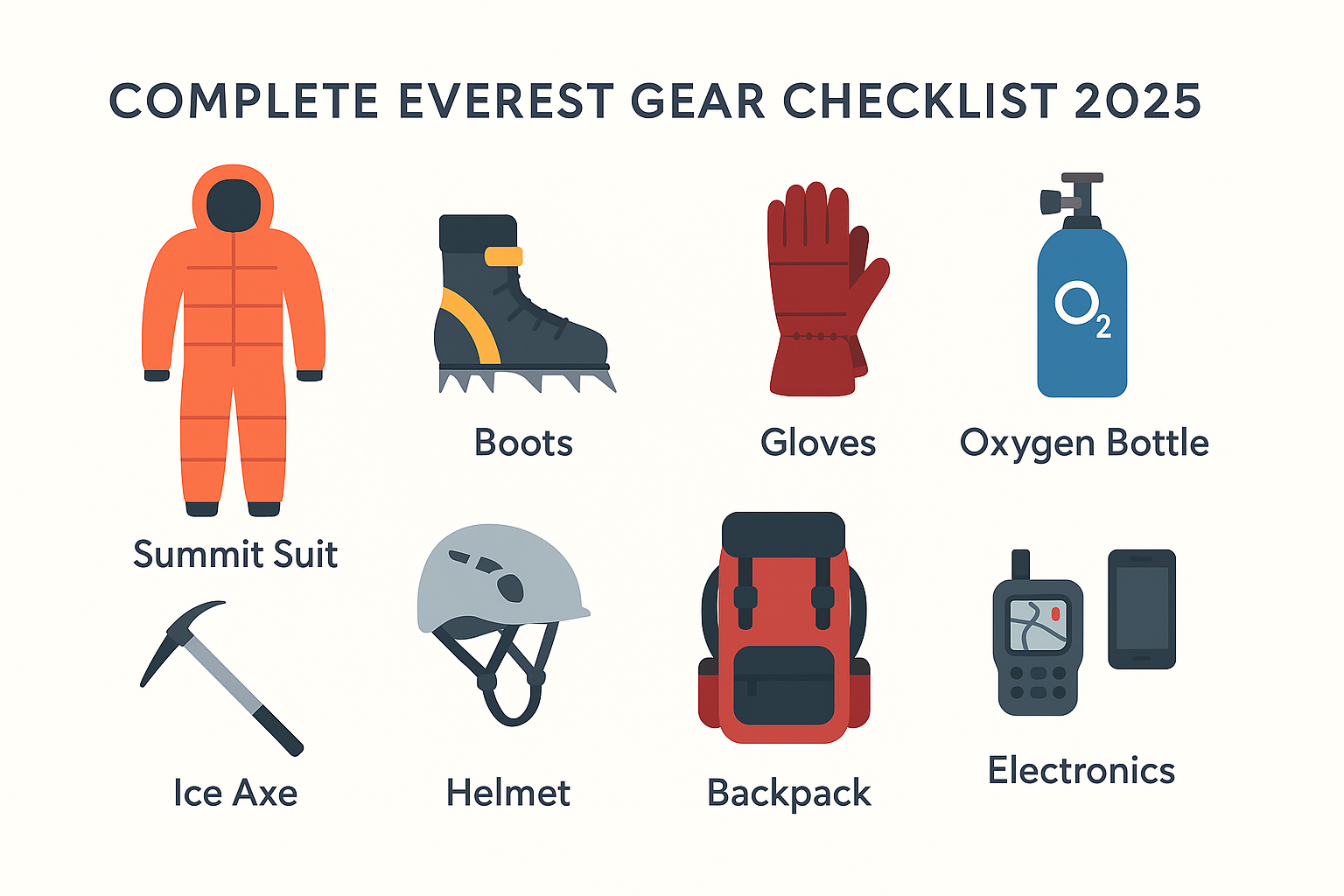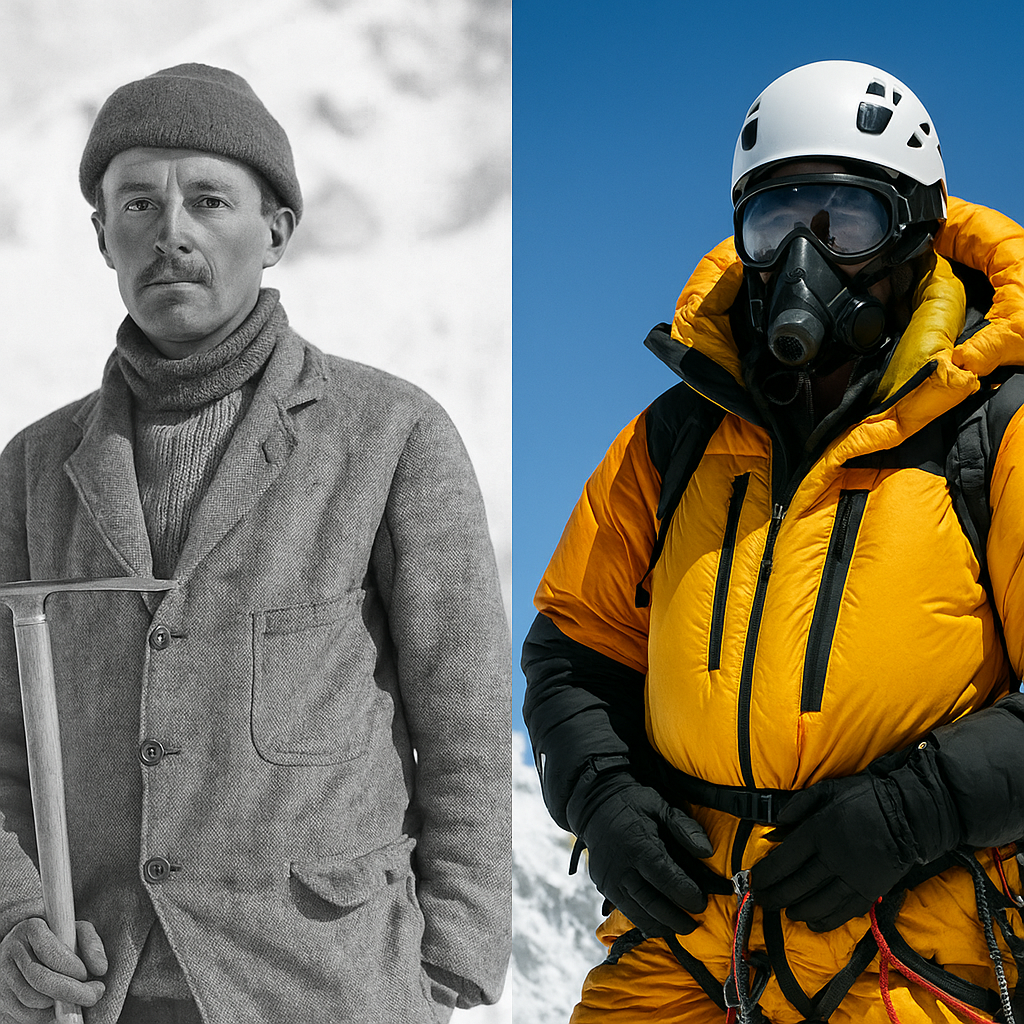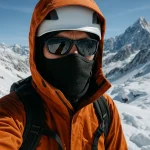Everest Gear: Essential Equipment & Modern Innovations
On Mount Everest, equipment is not about comfort—it’s about survival. In the Death Zone, above 8,000 meters, the human body is in a state of decay due to extreme cold, hurricane-force winds, and critically low oxygen levels. The right Mount Everest gear is the only thing that stands between a climber and the lethal environment.
This guide provides a comprehensive overview of an Everest equipment list, from the clothing that insulates you to the oxygen systems that keep you conscious. We’ll explore the evolution of this life-saving technology, from the tweed jackets of early pioneers to the space-age materials used today, and explain why every single item is critical for a chance at the summit.

Clothing & Summit Suit
The first line of defense against temperatures that can plummet below -40°C is a sophisticated layering system, culminating in the iconic Everest summit suit. The evolution from early explorers to modern climbers is a testament to material science.
From Mallory’s Tweed to Modern Down Suits
The famous Mallory clothing vs modern summit suits comparison highlights the incredible technological leap. George Mallory and Andrew Irvine attempted the summit in the 1920s wearing layers of silk, cotton, and wool under windproof gabardine and tweed jackets. While the best of their time, this gear was heavy, restrictive, and offered minimal insulation when wet.
Today’s suits are one-piece, down-filled marvels engineered for maximum warmth at minimum weight. Made with materials like Gore-Tex and Pertex Shield, they are fully waterproof, windproof, and filled with the highest quality 800-fill-power (or higher) goose down. Features like integrated zippers, insulated hoods, and reinforced sections make them highly functional for climbing. For a closer look, explore our guide to the modern summit suit.

Boots & Gloves
Frostbite is one of the most common and severe injuries on Everest. Protecting the extremities is non-negotiable, and modern Everest boots and gloves are highly specialized pieces of engineering.
Boots, Crampons, and Frostbite Prevention
Climbers use double or even triple-layer high-altitude boots. These consist of an inner insulating bootie, a rigid outer boot, and often an integrated, insulated gaiter. They are designed to be fully compatible with heavy-duty crampons required for climbing steep ice on the Lhotse Face or other technical sections of the climbing routes. The goal is to keep feet warm and dry, preventing the onset of frostbite.
Gloves and Mittens
Climbers use a layering system for their hands: thin liner gloves for dexterity, followed by insulated fleece gloves, and finally, thick down mittens for maximum warmth. Many climbers now use battery-heated gloves or mittens on summit day as an extra layer of protection against the crippling cold. For more on this, see our guide to boots and gloves.
Oxygen Systems
Supplemental Everest oxygen bottles are arguably the most important piece of modern Everest climbing technology. Using oxygen dramatically increases a climber’s chances of success and survival in the Death Zone.
A Brief History of Supplemental Oxygen
The first experiments with oxygen were conducted on the 1922 British expedition. These early systems were heavy, unreliable, and often leaked. For decades, the debate raged about whether using oxygen was “sporting.” Reinhold Messner and Peter Habeler famously settled the debate in 1978 by climbing Everest without it, but their feat remains an exception. For the vast majority, oxygen is essential.
Modern Oxygen Systems
Today’s systems are lightweight and efficient. A typical setup includes:
- Carbon Fiber Bottles: Far lighter than their steel predecessors, holding 3-4 liters of oxygen at very high pressure.
- Regulator: A device that controls the flow rate, usually set between 2 to 4 liters per minute (L/min).
- Mask: A specialized mask designed to function in extreme cold without freezing. Finding the best oxygen masks for Everest is a key part of preparation.
A climber will typically use 4 to 6 bottles during their summit push. Dive deeper into the technology in our guide to oxygen systems.
Technical Gear & Safety Tools
Beyond staying warm, climbers need tools to safely navigate the vertical and icy terrain. This is the core of the Everest climbing gear checklist.
- Ice Axe: Essential for self-arrest in case of a slip and for balance on steep slopes.
- Crampons: Spikes attached to boots for traction on ice and hard-packed snow.
- Harness: Worn by the climber to attach to ropes.
- Jumar (Ascender): A mechanical device used to ascend fixed ropes efficiently.
- Helmet: Protects against falling ice and rock.
On routes like the Southeast Ridge, teams of Sherpas fix thousands of meters of rope and place ladders across crevasses in the Khumbu Icefall, creating a lifeline to the summit that this gear is designed to interface with.
Sleeping & Base Camp Gear
While the summit push gets the most attention, climbers spend weeks acclimatizing and living on the mountain. The right camp gear is crucial for rest and recovery.
- High-Altitude Tents: Geodesic dome tents engineered to withstand hurricane-force winds and heavy snowfall.
- Sleeping Bags: Rated to -40°C (-40°F) and filled with high-quality down to ensure warmth during the coldest nights.
- Base Camp Comforts: Expeditions set up extensive base camps with kitchen tents, dining tents, and communication tents, often powered by solar panels.
Communication & Navigation
Modern technology has revolutionized safety and logistics on Everest. Staying connected is no longer a luxury but a critical part of expedition management.
- Satellite Phones & Radios: The primary tools for communication between climbers, base camp, and the outside world.
- GPS Trackers: Devices like a Garmin inReach allow teams to track a climber’s location in real-time and provide an SOS function.
- Drones: Increasingly used by teams to scout routes, especially through dangerous sections like the Khumbu Icefall, and for professional filmmaking.
Explore more in our overview of Everest communication tech.
Weight & Packing Strategy
A common question is, “How heavy is Everest gear?” While the total gear for an expedition weighs hundreds of kilograms, a climber’s personal load is carefully managed.
On summit day, a climber’s backpack typically weighs 10-15 kg (22-33 lbs), including an oxygen bottle, extra layers, water, and snacks. The total Everest expedition weight per climber is far greater, but the majority of team equipment, food, and tents is carried between camps by highly skilled Sherpas and porters. This support system is what makes modern commercial expeditions possible.
Future Innovations
The evolution of Everest gear is ongoing. The next generation of equipment will likely focus on being lighter, smarter, and more sustainable.
- Smart Wearables: Integrated pulse oximeters in gloves or base layers could provide real-time health data to climbers and their teams.
- Lighter Materials: Research continues into lighter and more efficient oxygen cylinders and stronger, lighter ropes and fabrics.
- Sustainable Gear: Brands are increasingly exploring PFC-free water-repellent treatments and recycled materials for expedition-grade equipment.
Key Takeaways
- The right Mount Everest gear is the single most important factor for survival and success on the world’s highest peak.
- The Everest equipment list includes a summit suit, high-altitude boots, an oxygen system, and technical climbing tools.
- Technology has evolved dramatically from the gear used by early pioneers like Mallory, making the mountain more accessible but not removing its inherent dangers.
- The high Everest gear cost reflects the advanced materials and engineering required to perform in the planet’s most extreme environment. Understanding the total expedition budget is crucial.
Frequently Asked Questions (FAQ)
What gear do you need to climb Everest?
To climb Everest, you need highly specialized gear including: a full-body down summit suit, triple-layer high-altitude boots, a supplemental oxygen system (bottles, mask, regulator), technical gear (ice axe, crampons, jumar, harness), a -40°C sleeping bag, and high-altitude tents. This essential equipment is designed to protect against extreme cold and the lack of oxygen in the Death Zone.
How heavy is Everest gear?
A climber’s personal gear worn and carried on summit day weighs between 10-15 kg (22-33 lbs). This includes the summit suit, boots, oxygen bottle, and backpack. The total expedition weight per climber, including all camp equipment and food, is much higher but is largely carried by porters and Sherpas.
What oxygen systems are used on Everest?
Modern oxygen systems on Everest consist of lightweight carbon fiber bottles, a regulator to control the flow rate (typically 2-4 liters per minute, up to 8 L/min for emergencies), and a specialized mask. Brands like Summit Oxygen and TopOut are commonly used. These systems are critical for survival above 8,000 meters.
How much does Everest gear cost?
The total cost for a complete set of personal Everest gear can range from $10,000 to over $30,000. Key expensive items include the summit suit ($1,000-$2,000), high-altitude boots ($1,000+), and sleeping bag ($800+). Many climbers rent some equipment to manage costs.
Daniel Whitaker is a mountain journalist and lifelong climber with over 15 years of experience in the European Alps and the Andes. Although he has not yet attempted Mount Everest, he has summited several 6,000-meter peaks in South America and multiple classic alpine routes in the Mont Blanc massif. Daniel specializes in writing about the culture, history, and psychology of mountaineering. His work combines first-hand mountaineering experience with extensive research on Himalayan expeditions, making him an engaging guide to Everest’s enduring myths, records, and inspirational quotes.

